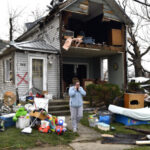Hawaii County officials say they need $800 million to recover from the Kilauea volcano disaster.
The Hawaii Tribune-Herald reports Managing Director Wil Okabe said last week that the county needs that amount to ensure the island’s long-term recovery from the recent eruption, which destroyed more than 700 homes and damaged infrastructure, including four state highways.
The county previously estimated a figure of $680 million.
Okabe says long-term needs include “emergency response, housing, infrastructure and public facilities, economic recovery, community planning, natural and cultural resources, health and social services.”
Okabe says the county needs $55 million to $60 million immediately.
Rep. Joy San Buenaventura of Puna calls the $800 million figure “a needs assessment, not a legislative” request. San Buenaventura says she thinks $23 million of the $55 million figure for immediate needs have been funded.
Meanwhile Hawaii’s Big Island continued to experience sharp declines in visitors and tourism spending last month amid Kilauea volcano’s eruption.
The Hawaii Tourism Authority said Thursday the number of travelers to the island sank 12.7 percent in July compared to the same month last year. Spending by visitors declined 7.2 percent to $201 million.
Lava mostly stopped flowing from the volcano early this month. It was vigorously erupting in July.
Tourists had few options to see lava because Hawaii Volcanoes National Park closed in May due to eruption dangers. There was also no public viewing area outside the park.
Overall, more than 939,000 visitors came to the state. That’s a 5.3 percent increase over July last year and a record high for any month.
Spending climbed 4.8 percent to $1.66 billion.
Officials say Hawaii Volcanoes National Park is on track to reopen several areas later this month since closing in May because of the Kilauea volcano eruption.
The Hawaii Tribune-Herald reports the National Park Service is planning to reopen several trails, roads and popular sites on Sept. 22, including the Kilauea Visitor Center, the Kilauea Iki Overlook, and a stretch of the Crater Rim Trail between Volcano House and the Kilauea Military Camp.
Ben Hayes, the park’s director of interpretation, says most of the popular areas and traveled roads will be opened.
He says additional repairs and openings might not occur until next year. The park will prioritize repairs based on cost and popularity, leaving less visited locations on the back burner.
Was this article valuable?
Here are more articles you may enjoy.

 South Carolina Allows Out-of-State Adjusters After Massive Hail Storm
South Carolina Allows Out-of-State Adjusters After Massive Hail Storm  Gallagher: Global Insured Natural Disaster Claims Again Dominated by Severe U.S. Storms
Gallagher: Global Insured Natural Disaster Claims Again Dominated by Severe U.S. Storms  California Chiropractor Sentenced to 54 Years for $150M Workers’ Comp Scheme
California Chiropractor Sentenced to 54 Years for $150M Workers’ Comp Scheme  EVs Head for Junkyard as Mechanic Shortage Inflates Repair Costs
EVs Head for Junkyard as Mechanic Shortage Inflates Repair Costs 